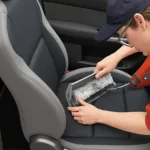Discovering a burn hole in your car seat can be disheartening, but don’t panic just yet! While it might seem like a daunting task, repairing a small burn hole in your car seat is often achievable with some basic materials and a bit of patience. Whether the culprit is a dropped cigarette or a mishap with a hot tool, this guide will walk you through the steps to mend that blemish and restore your car’s interior.
Assessing the Damage: When DIY is Possible
Before diving into the repair process, it’s essential to assess the severity of the burn hole. This step helps you determine if a DIY fix is feasible or if professional intervention is necessary.
- Size matters: Small burn holes, typically less than a quarter inch in diameter, are ideal candidates for DIY repair.
- Depth check: If the burn penetrates through the seat cover’s fabric, exposing the underlying foam, a more involved repair might be required.
- Fabric type: Leather and vinyl seats often respond well to DIY fixes, while cloth seats might require more specialized attention.
Gathering Your Repair Arsenal
Once you’ve determined that a DIY repair is suitable, gather the following materials:
- Cleaning Supplies: A gentle interior car cleaner, microfiber cloths, rubbing alcohol.
- Matching Fabric Scrap: This will be used to patch the hole. If you don’t have any, check with local upholstery shops or online retailers.
- Fabric Adhesive: Choose a strong adhesive specifically designed for fabric bonding.
- Scissors: For precise trimming of the fabric patch.
- Tweezers: For handling the fabric patch and any loose fibers.
- Optional: Leather filler (if repairing a leather seat), color-matching fabric dye.
How to Repair a Small Burn Hole: A Step-by-Step Guide
Follow these steps carefully to repair the burn hole effectively:
- Clean the Area: Using a gentle car interior cleaner and a microfiber cloth, thoroughly clean the area around the burn hole. This removes any dirt or debris that might hinder adhesion.
- Prepare the Patch: If the burn hole has created a raised edge, carefully trim it down using fine-grit sandpaper or a sharp blade. Be sure to work slowly and avoid damaging the surrounding fabric.
- Cut the Patch: Using the tweezers, insert a small piece of the matching fabric scrap into the hole, ensuring it sits slightly below the surface of the seat cover. Secure the patch in place with a small amount of fabric adhesive.
- Apply Adhesive: Carefully apply a thin layer of fabric adhesive around the edges of the hole, ensuring it makes contact with the underside of the fabric patch.
- Bond the Patch: Gently press down on the patch, ensuring it adheres firmly to the seat cover. Use your fingers or a smooth tool to smooth out any wrinkles or air bubbles.
- Drying Time: Allow the adhesive to dry completely as per the manufacturer’s instructions.
- Final Touches: If necessary, use a color-matching fabric dye to blend the patch seamlessly with the surrounding fabric.
 Applying Fabric Adhesive to Repair Burn Hole
Applying Fabric Adhesive to Repair Burn Hole
Repairing Larger or More Severe Burns
For larger burn holes or those that have damaged the underlying foam, seeking professional upholstery repair might be the best course of action. A skilled upholsterer can assess the damage and recommend the most suitable repair method, whether it involves patching, replacing a section of the seat cover, or reupholstering the entire seat.
Preventing Future Burn Holes: Tips to Safeguard Your Car’s Interior
Prevention is always better than cure! Here are some proactive measures you can take to minimize the risk of future burn holes in your car seats:
- Exercise Caution with Cigarettes: If you smoke in your car, use a designated ashtray and be extra cautious when handling lit cigarettes.
- Mind Hot Objects: Be mindful of hot objects, such as hair styling tools or heated beverages, that could come into contact with your car seats.
- Consider Seat Covers: Using durable seat covers can provide an extra layer of protection against spills, burns, and general wear and tear.
Seeking Professional Help: When to Call the Experts
While DIY repairs can be effective for small burn holes, there are instances where professional help is advisable. Consider contacting a reputable car upholstery repair shop if:
- The burn hole is large or deep: Extensive damage often requires specialized tools and expertise for proper repair.
- The seat cover is made of delicate material: Leather, suede, or other delicate fabrics might require specialized handling to avoid further damage.
- You’re unsure about the repair process: If you’re not confident in your ability to repair the burn hole effectively, it’s best to leave it to the professionals.
Conclusion
Repairing a small burn hole in your car seat doesn’t have to be a daunting task. By following the steps outlined in this guide, you can often fix minor burns yourself, saving time and money. Remember to assess the damage carefully, gather the necessary materials, and proceed with patience and attention to detail. However, don’t hesitate to seek professional help if you encounter a larger or more complex burn hole, as expert intervention can ensure a seamless and long-lasting repair.


